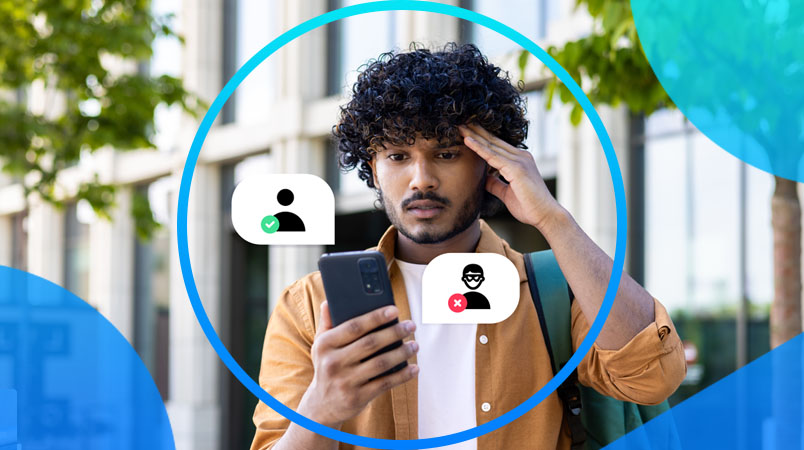A2P Messaging & Fraud
With A2P, or application-to-person messaging, we describe any kind of traffic where a person receives messages from an application. It can happen via a variety of channels, ranging from SMS, to popular messaging channels, to Voice. Sounds vague, but trust me, it's not!
Just think about appointment reminders, delivery notifications, One Time Passwords (OTP's), and even chatting with a chatbot. These are all examples of A2P messaging.
A2P messaging obviously comes with a lot of benefits for businesses, and it can truly make or break a customer experience. But nothing comes without a downside. Where there is technological advancement, there will be criminals trying to take advantage of it.
As a business, you can take preventative measures to minimize the threats of A2P messaging fraud, such as implementing two-factor authentication, monitoring traffic, and many other security strategies.
Read all about A2P messaging fraud prevention for your business >
You as a business are not the only one these criminals will target though. Your customers will also be at risk to become the next victim of A2P messaging fraud. To better understand the threats, let's take a look at the most common cases of fraud that your customers will face, and what you can (educate and instruct your customers to) do to minimize these threats.
Common A2P Messaging Fraud for Consumers
Phishing, Smishing, and Vishing
Phishing is a form of internet fraud where scammers pretend to be a reputable company or business (like yours), trying to lure their victims to fake websites, and trying to get them to reveal personal information, passwords, PIN numbers, credit card numbers and more. phishing happens mostly via e-mail.
Smishing, a word jumble of SMS and phishing, is the fraudulent practice of sending text messages to try and scam victims in a similar manner to Phishing. Smishing primarily happens over SMS, but can also expand to other messaging channels such as WhatsApp, Facebook Messenger, and Instagram Messaging.
Vishing, or voice phishing, describes Phising attacks over telephone. Criminals will make phone calls - or leave voice messages- pretending to be somebody from a reputable company. This way, they hope to lure their victims into giving out their personal details.
Spoofing
Spoofing, or Voice Caller ID spoofing, is similar to phishing (and smising, and vishing), because fraudsters are also pretending to be somebody they're not. In the case of spoofing, these scammers polish up their bad actor skills to claim a false identity, often accompanied by false e-mail addresses or telephone numbers. The messages they send can appear to be from a legitimate source and they often contain malicious links that will compromise your devices.
Spamming
The annoying messages you cannot seem to unsubscribe from: spam. Spammers send unsolicited text messages to a large number of recipients, hoping that anybody will bite.
Wangiri
Wangiri - Japanese for ' one (ring) and cut' is a telephone scam where criminals will call the number of your customers, and hang up after it rang once. By doing so, they hope to trick people into calling them back, to a premium rate number that will cost them loads of money.
How to Help Protect Your Customers From A2P Messaging Fraud
You don't want your customers to fall for a scam. Especially not when criminals are using your company's reputable name as their disguise to swindle information and personal details from your loyal customers. But what can you do to help prevent this?
Educate Your Customers on Your Company Policy and the Threats
Let your customer know what they can - and can't expect from your company. Will you never contact your customers by telephone? Let them know! By defining the types of communication they can expect from your business, they are less likely to fall for fraudsters imitating to be you.
We will never ask for your personal information or bank details. If you see any suspicious activity, calls, or messages, please let us know via [email protected].
Also, make sure that your customers are aware of your security policies. You can set up a long list of security measures, but it'll be in vain when your customers are hesitant to adopt these (extra) security steps because they don't know about them, or don't understand the value. Make them see the value of extra security steps (like adding two-factor authentication to their accounts), and they'll be more willing to take those extra (security) steps.
Implement 2FA (Two-Factor Authentication)
Two-factor authentication (2FA) is a type of MFA (Multi-Factor Authentication) that requires two factors of identification to verify the user’s identity. The factors of identification are:
Something a user knows, like a PIN or an answer to a secret question
Something a user possesses, like a one time password (OTP) delivered via SMS text message
Something a user is, which may include fingerprints and facial recognition
Most customers are probably already used to 2FA in their daily lives, as they use it to log into various different applications. 2FA is applicable in many different industries and on a multitude of different (messaging) channels, making it an effective and accessible measure against A2P messaging fraud. Implementing 2FA will add an extra layer of security to the accounts of your customers, decreasing the possibilities for unauthorized access.
Read about 2FA on all the different messaging channels >
Use Spam Filters
Block, or give your customers the option to block those annoying unsolicited spam messages with a spam filter to ensure only legitimate messages are delivered.
CM.com as Your A2P Messaging Provider
We hope that this short blog has given you an idea of the risks your customers face now that A2P messaging it on the rise. Make sure that you educate them well and communicate clear expectations and boundaries for customer engagement.
Want to get started with your own A2P messaging strategies, and protect your customers accordingly?
CM.com offers A2P messaging on a multitude of channels via our communications platform, or our integrated communications software suite Mobile Service Cloud and Mobile Marketing Cloud. We also offer an OTP (one-time-password) solution to help you set up your own 2FA strategy.







